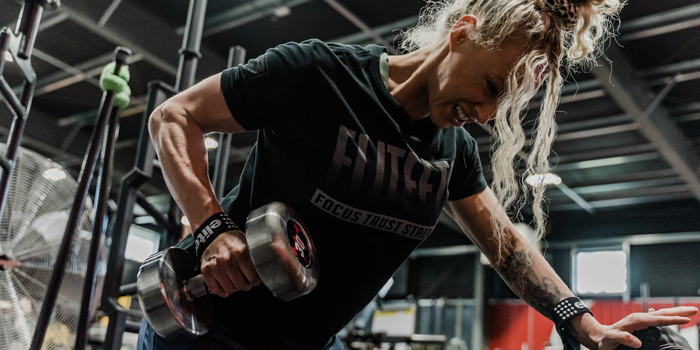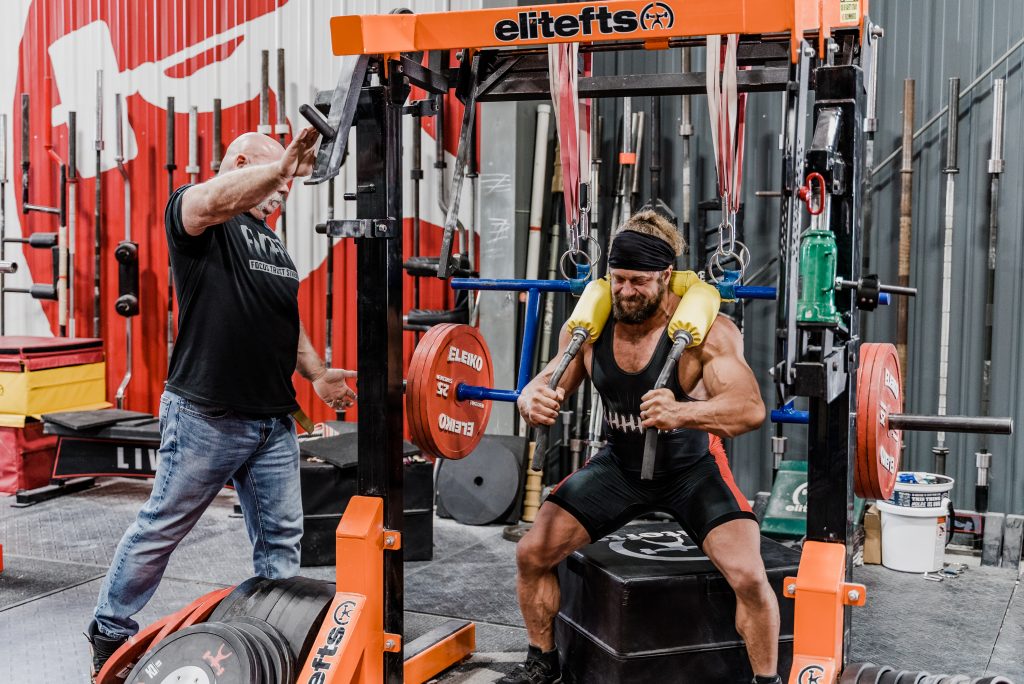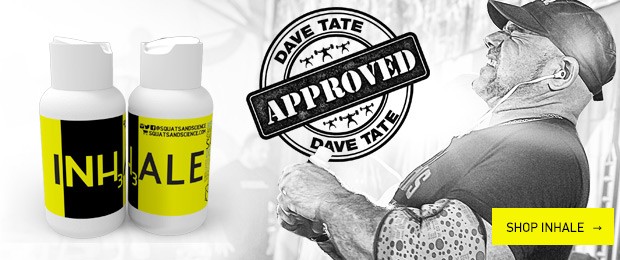
There are so many factors to consider when it comes to strength programming. Unfortunately, while floating through this sea of programming, many athletes grab so tightly to the factors that won't keep them afloat. Such as getting too caught up in percentages, reps, and sets. What about the lifters that want to be told what to do? I digress. I want to talk about the intensity and intent factors in strength programming and their effect on training in this article—the stuff that matters. These two factors are much more important than so many other factors, and they can literally make or break a program.
How you approach and execute your program is crucial. If you're going through the motions, even the best program will reward you with minimal results. On the flip side, attacking the program with full aggression every training day can also reward you with minimal results. As with all of life, there is balance, and training programs are no different. You must understand how the program was designed to be performed. Many athletes I see do not give this much thought at all. In fact, many programs speak little about this.
Intent
These days, words can mean many things to many people, so I am becoming a fan of clearly defining words. Let's talk about intent. I love the word intent. I love the way it sounds, and I love screaming it at clients. When I scream that word, it encompasses everything I have taught them. When you lift with intent, you have 100 percent focus on your technique. You are performing every little detail with 100 percent efficiency and 100 percent of your ability. This does not mean acting like a meathead making a lot of noise and putting on a big show just trying to push the weight up.
RECENT: 12 Tips for a Stronger, Safer, More Efficient Bench Press
It's a razor's edge focus on every minute detail of a lift—rooting, bracing, proper intra-abdominal pressure (IAP), and as close to perfect technique as possible. It means flexing and relaxing different muscles in perfect unison when working with heavy or light weight. I am talking about every movement you make despite the weight—one hundred pounds and one thousand pounds on the bar performed the same way. Maximal intent every time a movement is performed and through the whole movement, not just the concentric. The intent of complete proper and efficient movement.
Intensity
There is a very close correlation between intensity and intent. In fact, I believe you can change the intensity of your intent. For example, not squeezing as hard or not building max IAP could be intent with less intensity. Less IAP and tightness but still working hard to be in solid technique. So, intensity is more of a measurement of intent that can be turned up or down like the volume on a stereo.
Intensity can also be used in terms of a whole training session. On a max effort day, when you know you're going for a one-rep max or a high percentage day, you're most likely going in with high intensity. You know you're going to putting maximal effort in a low rep lift. On a recovery or GPP (general physical preparedness) training day, you will still be putting in maximal intent, but the intensity will be much, much lower. Both of these kinds of sessions will be taxing but in different ways.

Nowadays, these concepts seem extremely simple to me. I admit to sometimes getting frustrated with lifters that do not seem to understand them. It takes a little bit of reflecting on calming that frustration down. You see, there was a time I didn't understand these terms. When I was young, I used to train extreme, or so I thought. For example, my squat sessions lasted until I could not physically get back up the stairs. If I could walk up them, I would turn back and train more. It wasn't until many years later that I finally figured out what it's like to really train with intent and intensity. I now understand those sessions were taxing, but they were not as hard as they seemed at the time. These days I can push way beyond how taxing those sessions were.
I run into this situation with lifters all the time these days. When I do seminars, lifters will tell me how sore and tired they are even though they didn't lift that heavy. Almost all my clients eventually mention how they thought they use to train hard. Don’t get me wrong, we all trained hard before, but it's nothing like training with intent and intensity. Sessions back in the day where I'd fall asleep next to my bench after training are nothing compared to how hard I learned to really push my body. This is a skill that does not get developed overnight or without a ton of hard work. This is the ability to push yourself past just working your muscles. It is working your CNS and mental capacity to the point where you can build real strength.
Technique
So let's try to break this down a little bit. There are many programs based on percentages of a max lift. A new lifter with horrible technique is probably trying real hard and hits what is a max lift for them. A more experienced lifter pushes even harder to hit their max lift. How close is the new lifter to his true max compared to the more experienced lifter?
The new lifter may have struggled and felt they went all out, but in reality, that lift is only a max with horrible technique and no real ability to lift with intent or intensity. Even with their current strength, they would lift much more weight if they had better technique, intensity, and intent. So in all reality, these lifters' one-rep maxes are completely different. The experienced lifter is close to a true max, where the beginner is actually pretty short of their true max. This is because the beginner does not yet have the ability to hit a true one-rep max.
Recovery
Now let's look at this in terms of recovery from a training session. Take the same two lifters as I described earlier. Say they do the same training session with the same percentage of their max. Which lifter do you think is going to need more recovery? The more experience lifter is going to push his muscles and CNS way more than the beginner. This is true even if both of them push themselves very hard and are doing the same percentages of their max. The more experienced lifter stressed their body way more than the less experienced lifter and will most likely take longer to recover. This is why newer lifters can often train way more often than experienced lifters can. They simply have not acquired the skills of the experienced lifter.
Autoregulation
Now, there are strength programs out there based more on autoregulation. I find them very interesting. I feel they do a better job of regulating optimal training for athletes, but they still run into problems. A velocity-based training program uses bar velocity to regulate how the athlete is doing each session. In this case, we have the same situation, though an experienced lifter will generate better velocity through technique, intent, and intensity. The solution may be to start with base velocities when the body is fully recovered. So over time, the athlete should become faster.
You can always have a base to check for overtraining to regulate programming. There are also programs based on the rate of perceived exertion. Again, I find this to be an interesting idea, but the athlete's experience will affect this. A new lifter does not have a very good idea of this rate because they have not really learned to push themselves. If their technique is bad, a lift may feel very hard when it is not necessarily a maximal type weight. There is also the issue of athletes overestimating themselves. This is easily solved by a good coach who learns the lifters' perceived rates compared to what they really are. Either way, I am glad to see training moving in this direction.
I have often said that if there were one perfect program that worked for everyone, there would only be one program. Instead, we have too many for me to count, and all of them work for someone. Generally speaking, I think the simpler the program, the better. This is not rocket science or curing cancer. A simple program with intensity, intent, and great execution is one of the best routes a lifter can take. Less importance on the exact reps, sets, percentages, etc., while focusing on intensity, intent, and execution will reap whirlwinds of strength.
Chad Aichs is a world-class and elite powerlifter in the SHW division. He began training seriously for powerlifting in 1999 in Sparks, Nevada, where he still currently trains at American Iron Gym. In the ten years since he started, Aichs has proven to be one of the strongest lifters in the world. His best lifts are an 1173 squat, 821 bench press, and a 755 pull. Aichs' best total is 2733, which makes him one of the top lifters of all time.











There have been numerous studies that concluded that your intent to move fast, powerfully is more important (in developing speed & power) than actually doing so.
Your "intent" can change depending on the exercise, movement and goal of the session. Are you looking to work on technique, power, max strength, etc.
Thanks for the comment,
Chad
Quick question, how do you take care of your bone, ligament and tendon health while lifting heavy? I've only recently started working out, and my trainer advices me to go heavy on most of the exercises. As I recall, I've seen bodybuilders lifting heavy during their initial days but later go through several injuries. How do I ensure I'm lifting heavy, while also taking care of my bone health?
Thanks in advance!
Part of taking care of your bones and ligaments is to stress them. Lifting heavy stresses them so they can recover to be denser, thicker, and stronger. The key is to let them heal and not to be beating them up all the time. Meaning if you continue to overtraining over the long run you will get injuries. Overtraining has its place just not all the time. It is important to focus on your recover and all the things that speed that process up. Plenty of sleep, solid nutrition, stretching, modalities, etc. There is always risk of injury when lifting heavy but if you focus on recovery while listening to your body you can greatly reduce this.
Thanks,
Chad
https://oursafetysecurity.com/lift-hard-hat-reviews/